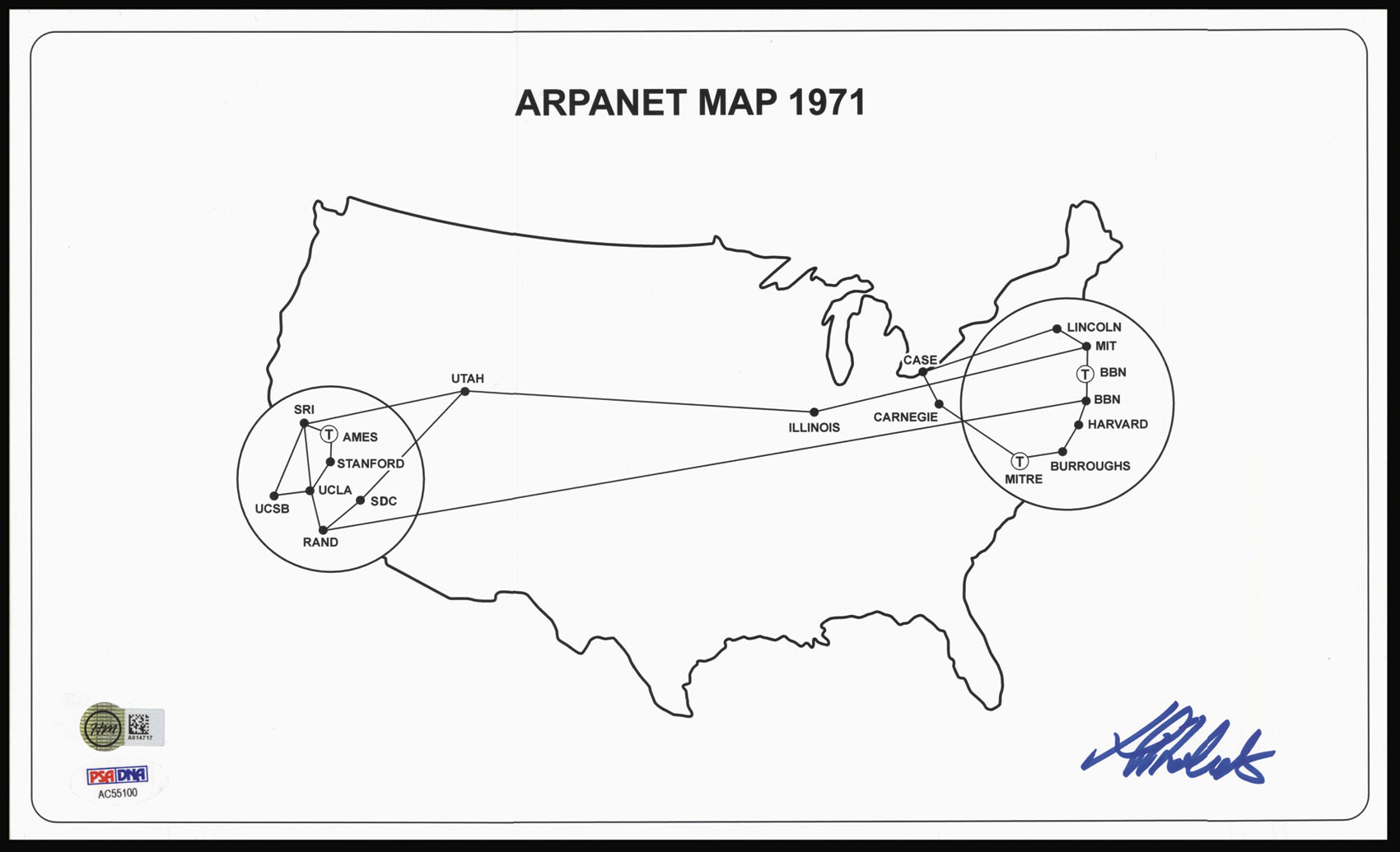

The internet before the Internet
ARPANET Map 1971.
- 作者: ROBERTS, Lawrence
- 出版地: Burlington, Mass,
- 出版商: Bolt, Beranek and Newman,
- 发布日期: January 4, 1978.
- 物理描述: Lithographed map on heavy stock.
- 方面: 215 by 355mm. (8.5 by 14 inches).
- 库存参考: 14918
笔记
Showing the reach of the Advanced Research Projects Agency Network, ARPANET, in September 1971, across the U.S.A., from California to New England. Published as part of the 'ARPANET Completion Report', Burlington Mass, January 4th 1978. ARPANET, was the progenitor of the Internet, funded by the United States Department of Defence, and made use of Donald Davies' pioneering packet switching technology as the basis for a network, which, by the time this map was issued, extended to include packet satellite networks, ground-based packet radio networks and other networks. On this map 18 main packet switching hubs are recorded at: UCSB, SRI, Ames, Stanford, UCLA, RAND, SDC, Utah, Illinois, Case, Carnegie, Mitre, Burroughs, Harvard, BBN (2), MIT and Lincoln. The first map in the report, shows the ARPANET dated December 1969, with only 4 hubs: UCSB, UCLA, SRI,and Utah. By March 1997, the map included a network of more than 50 hubs.
The map is signed by the original programme manager at the ARPA, Lawrence G. Roberts (1937 - 2018), who in 1966 "drew a series of abstract figures on tracing paper and a quadrille pad. Some resembled a game of cat's cradle; others looked like heavenly constellations; still others like dress patterns. Those curious drawings were the earliest topological maps of what we now know as the internet... Dr. Roberts was considered the decisive force behind packet switching, the technology that breaks data into discrete bundles that are then sent along various paths around a network and reassembled at their destination. He decided to use packet switching as the underlying technology of the Arpanet; it remains central to the function of the internet" (Hafner).
The Internet "as we now know it embodies a key underlying technical idea, namely that of open architecture networking. In this approach, the choice of any individual network technology was not dictated by a particular network architecture but rather could be selected freely by a provider and made to interwork with the other networks through a meta-level 'Internetworking Architecture'. Up until that time there was only one general method for federating networks. This was the traditional circuit switching method where networks would interconnect at the circuit level, passing individual bits on a synchronous basis along a portion of an end-to-end circuit between a pair of end locations. Recall that Kleinrock had shown in 1961 that packet switching was a more efficient switching method. Along with packet switching, special purpose interconnection arrangements between networks were another possibility. While there were other limited ways to interconnect different networks, they required that one be used as a component of the other, rather than acting as a peer of the other in offering end-to-end service (Barry Leiner, 'A Brief History of the Internet, Version 3.2', 1997 online). So there...
The map is signed by the original programme manager at the ARPA, Lawrence G. Roberts (1937 - 2018), who in 1966 "drew a series of abstract figures on tracing paper and a quadrille pad. Some resembled a game of cat's cradle; others looked like heavenly constellations; still others like dress patterns. Those curious drawings were the earliest topological maps of what we now know as the internet... Dr. Roberts was considered the decisive force behind packet switching, the technology that breaks data into discrete bundles that are then sent along various paths around a network and reassembled at their destination. He decided to use packet switching as the underlying technology of the Arpanet; it remains central to the function of the internet" (Hafner).
The Internet "as we now know it embodies a key underlying technical idea, namely that of open architecture networking. In this approach, the choice of any individual network technology was not dictated by a particular network architecture but rather could be selected freely by a provider and made to interwork with the other networks through a meta-level 'Internetworking Architecture'. Up until that time there was only one general method for federating networks. This was the traditional circuit switching method where networks would interconnect at the circuit level, passing individual bits on a synchronous basis along a portion of an end-to-end circuit between a pair of end locations. Recall that Kleinrock had shown in 1961 that packet switching was a more efficient switching method. Along with packet switching, special purpose interconnection arrangements between networks were another possibility. While there were other limited ways to interconnect different networks, they required that one be used as a component of the other, rather than acting as a peer of the other in offering end-to-end service (Barry Leiner, 'A Brief History of the Internet, Version 3.2', 1997 online). So there...
参考书目
- Katie Hafner,Roberts' obituary for the 'New York Times', December 30, 2018
图片库
/
 地图
地图  地图集
地图集  珍本
珍本  版画
版画  天文仪器
天文仪器 










